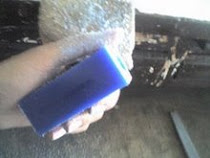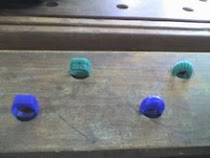Pegado y Faceteado de Piedra Preciosa
Talla de Piedras - Parte 1
Talla de Piedras - Parte 2
jueves, 15 de mayo de 2008
No one knows how long ago man developed a love for gems. Every civilization unearthed by archeologists show that its members prized certain colorful minerals for personal ornamentation or sometimes, as in de case of jade of the Chinese, held some as a sacred. The cutter and carver of gem materials enjoyed special privileges because only he knew the secrets of stones entrusted to his care and, seemingly by magic, could shape them to his will despite the fact that they were supremely harder than the finest metals. The ancient Greeks, and after them the Latin's, gave to us lapidary, from lapis, or stone, as the name of the artisan who carves, shapes, or engraves precious stones or gems. For hundreds of years the art of the lapidary was a secretive one and only in the last few decades has it become known, to the point where anyone at all can learn how to fashion the raw material –gemstones- into gems, carving, and many other objects of ornament.
Before we go further, it is a good idea to define gemstone, since the term does not always refer to a mineral. Originally, most raw materials used for gems came from the rocks and minerals in the earth’s crust, but in a few favored places in the world, primitive man discovered beautiful pearls within oysters and, in certain sedimentary formations, amber and jet; and because of their beauty and value, they too were classed as gemstone. Later, such materials as tortoise shell, pearl shell, coral, and a number of types of ivory were added to the list, and in most modern books on gemology, these are described and discussed along with mineral gemstones.
MINERAL GEMSTON
About 150 years old, Arthur Aikin, Secretary to he Geological Society of Great Britain, wrote a small mineralogy is which he listed about 250 minerals that were well recognized at the time.
By the close of the nineteenth century, the list had grown to about 750 species, today it is over 2000. Despite the rapid rise in the number of minerals recognized as separate species, there are still only about a hundred that provide gems from suitable pieces of rough, of these, only about twenty-five are known to the layman.
The mineral species furnishing the principal gemstone of greatest value, or the classical precious stones, are:
Diamond
Corundum (ruby and sapphire)
Beryl (esmerald, aquamarine, etc.)
Crysoberyl (alexandrite, catseye, etc.)
Opal (White and black)
The following species furnish important gemstones, or those regularly handled in the gem and jewelry trade:
Feldspar group (moonstone, amazonite, etc.)
Garnet Group
Jadeite
Nephrite
Olivine (peridot)
Quartz (amethyst, citrine, chalcedony, etc.)
Spinel
Topaz
Tourmaline
Turquoise
Zircon
At this point it is wise to distinguish between certain gemstone that are compose of several minerals and, hence, are ore like rocks, geologically speaking, than single mineral species. Prominent among such are marbles, which though usually composed of a single species, in this instance, calcite, occur in such quantity that they are classed as rocks rather than as large masses of as single mineral. Other rocklike gemstone are serpentine, lapis lazuli, various granites, and other stones that may or may not be good enough to use in jewelry but are frequently carved or cut into ornamental objects, often of large size. The following list of gemstones of lesser importance includes both mineral species and rock types, the latter designated by the letter R:
CALCITE (R)
FLUORITE
GYPSUM (R)
HEMATITE ®
IDOCRASE
LAPIS LAZULI®
MALACHITE
OBSIDIAN
PYRITE
RHODONITE
SCAPOLITE
SERPENTINE ®
SODALITE
SPODUMENE
STEATITE ®
THOMSONITE
VARISCITE
ZOISITE
The following gemstones are so rare, or for some reason unsuited for use in jewelry, that they are seldom seen outside collections:
Amblygonite
Anatase
Andalusite
Apatite
Apophyllite
Azurite
Benitoite
Beryllonite
Brazilianite
Brookite
Cassiterite
Danburite
Datolite
Diopside
Dioptase
Enstatite
Epidote
Euclase
Hambergite
Hemimorphite
Iolite
THE QUALITIES OF GEMSTONES
What qualities distinguish gemstones from ordinary rocks and minerals? Why are certain of them prized and others scorned? There is no doubt that the most important quality is beauty, for without it, a mineral or rock will not be prized, regardless of what else it has. Gemstones are therefore attractive to the eye, primarily because of vivid coloration, often enhanced by clever cutting, but also because of intriguing patterns, inclusions, or some other characteristic that lifts them above the ordinary.
Beauty is evident in the strong coloration of red ruby, blue sapphire, and green emerald, but it is also visible in the patterns of agate, in the spangles of aventurine, and in the gleaming coppery needles of rutilated quartz.
Since gems are meant to be worn, they are liable to be rubbed, chipped, or knocked against hard objects. It is important that they resist this quality soon proves it self in gems set in rings or bracelets. Those that are strong and hard, like diamond, ruby, sapphire, and chrysoberyl, will sparkle and gleam with undiminished luster after years of wear have eroded the gold or platinum of the settings to the point where stones may be lost unless the settings are repaired. On the other hand, durability is not all-important.
Consider opal as an example: this gemstone is brittle and soft, and, when worn in rings, soon
Nadie sabe desde hace cuanto tiempo el hombre avenido desarrollando el amor por las gemas. Todas las civilizaciones descubiertas por los arqueólogos muestran que valoran el color de los minerales para ornamentos personales o algunas veces como en el caso del jade en la china, que es considerado como sagrado. El cortador y el tallador de las gemas disfruta de privilegios especiales porque solo ellos saben los secretos de las piedras confiadas a su cuidado, asemejando esto a magia, podían darle forma a su gusto a pesar que fueran mas duras que los metales mas finos. Los antiguos griegos y luego los latinos nos dieron el nombre de lapidary, de lapis, o piedra, como el nombre del artista que talla o esculpe piedras preciosas. Por cientos de años el arte de la talla era un secreto y solamente en la ultimas décadas a llagado hacer conocido, hasta el punto en que cualquier persona puede aprender el embellecimiento del material en bruto – gemas-, tallando, y en muchos otros objetos de ornamentación.
Antes de continuar, es bueno definir el término de gema, porque no siempre se refiere a un mineral. Ya que originalmente mucha de la materia prima transformada en gema proviene de las rocas y minerales que encontramos en la corteza terrestre, pero en algunos lugares del mundo el hombre primitivo descubrió bellas perlas en las ostras y formaciones de sedimentos ámbar y azabache; que por su belleza y valor, ellos también fueron clasificados como gemas. Luego materiales semejantes como caparazones de tortuga, perlas, corales y varios tipos de marfil se agregaron al a lista en muchos y modernos libros de gemología, esto a sido descrito y discutido junto con los minerales de las piedras preciosas.
GEMAS MINERALES
Cerca de 150 años antes, Arthur Aikin, Secretario de la Sociedad Geológica de Gran Bretaña, escribió un pequeño mineralógico, en cual incluyo cerca de 250 minerales que fueron reconocidos a la época. A finales del siglo 19 la lista había crecido cerca de 750 especies, hoy están cerca de los 200. A pesar del rápido crecimiento, en el número de minerales reconocidos como especies separadas Aun hay únicamente cerca de 100 que proveen gemas de pedazos ásperos de estos, solo 25 son conocidas por el hombre inexperto.
Las especies minerales suministran las principales gemas de gran valor, las clásicas piedras preciosas son:
Diamante (rubí, zafiro)
Berilio (esmeralda, aguamarina, etc.)
Crisoberilo (Alexandrita)
Ópalo (negro y blanco)
Las siguientes especies producen gemas importantes o, regularmente manejadas como gemas en el comercio joyero:
Grupo feldespato
(Piedra luna amazonita)
Grupo jadeíta
Nefrita
Cuarzos (amatista, citrino)
Calcedonia
Espinel
Topacio
Turmalina
Turquesa
En este punto es prudente distinguir entre gemas seguras compuestas de importantes minerales y por lo tanto son mas bien rocas, geológicamente hablando, que simples especies
Minerales, notablemente entre tales esta el mármol, el cual sin embargo usualmente esta compuesto de unas particulares especies, para este caso, calcita, sucede en tal cantidad que clasificada como roca mas bien de grandes masas de un solo mineral, otras gemas que lucen como roca son:
Serpentina
Lapislázuli
Varios granates que otras piedras que pueden ser o no ser talladas o cortadas entre objetos ornamentales, frecuentemente de gran tamaño, la siguiente lista de gemas de menor importancia incluidas ambas especies minerales y tipos de rocas estas ultimas designadas por la letra ®
Calcita ®
Fluorita
Malaquita
Obsidiana ®
Sinhalita
Pirita
Rodonita
Escapolita
Serpentina ®
Sinhalita
Esmilsonita
Sodalita
Estactita ®
Thomsonita
Variscita
Zoisita
Lapislázuli®
Las siguientes gemas son raras o por alguna razón inútiles para ser usadas en joyería que rara vez se ven en colecciones.
Ambligonita
Anatase
Andalusita
Apatito
Axinita
Azurita
Euclasa
Hamberguita
Olita
LAS CUALIDADES DE LAS PIEDRAS PRECIOSAS
Que cualidades distingues de las piedras preciosas desde piedras ordinarias y minerales?
Por que son ciertamente algunas piedras premiadas y en otras despreciadas?
Esto no es de dudar que las más importantes cualidades es belleza. Ya que sin ella un mineral o roca no será apreciado. No importando lo que esta tenga de más.
Piedras preciosas son por tanto atractivas para el ojo, principalmente a causa de su viva coloración, a menudo la mano de corte lo refuerza. Pero también debido a adornos en su estructura como inclusiones o algunas otras características que la elevan sobre todo lo ordinario. Belleza es evidente en su fuerte coloración de rojo rubí, azul zafiro, y verde esmeralda, pero esta también es visible en estructuras de Ágata, en el brillo de la aventurina y las relucientes agujas cobrizadas en el cuarzo rutilado.
Significa que las gemas estaban bajo desgaste y, estas eran obligadas a ser frotadas, astilladas o golpeadas contra objetos duros. Esto es importante que estas resistan estos tratamientos. Para ser durable. Es importante que la cualidad sean probadas por si mismo en juegos de anillos y brazaletes.
Aquellos que son fuertes y duros, gustan diamantes, rubí, zafiro, y crisoberilo, puede destellar por que no disminuye después de años de uso tiene corrosión el oro o platino, en el punto de engaste, donde las piedras pueden desaparecer a menos que la montura sea reparada. De otra forma, durabilidad no es muy importante. Un ejemplo que se considera es el ópalo: estas piedras preciosas son quebradizas y blandas y es cuando el anillo se desgasta.


